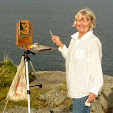Sky Before Sunrise
6"x8"oil on canvas
Black paint was used in this sky.
You may never have heard the term "Oxford comma", but you've likely seen it many times. It's the second comma in the phrase "red, white, and blue". Also called the serial comma, whether to use it is a matter of personal preference. You can read more about the pros and cons here. Recently overhearing a conversation about the comma, I started to think about what is a similarly controversial topic in painting, of which I'm sure there are many!
The topic I came up with is whether to include black paint on your palette, or to mix your blacks from other colors. Once again, this is a matter of personal preference. Those on the pro side include the tonalists, who use black to limit chroma, even in their skies. Deborah Paris' online class "The Painted Sky" is a great way to learn this approach. I painted the top example in that class. Black is also commonly used with various yellows to make greens. Of course there is more than one black paint on the market. The most common are Mars black, Lamp black, and Ivory black. Mars black is made from iron oxide, Lamp and Ivory black are made from carbon. The later are somewhat transparent and slow drying, the former is opaque. For more information look here and on wetcanvas.com. I've read comments online as to which of these blacks is more warm or cool, but it sounds like the variations between the manufacturers may swamp this. The bottom line is you'll have to try them for yourself.
Sternman
16"x20" oil on canvas
There was no black paint used in this painting.
On the con side, black paint is said to dull or kill whatever it's mixed with, and thus mixed darks, lacking this characteristic, are preferred. Some popular combinations are burnt sienna or burnt umber with ultramarine blue and alizarin crimson with viridian. If you're willing to mix three colors, there are many possibilities. Personally I like transparency in my darkest darks, so burnt sienna and ultramarine blue work well, and can be mixed to a strong black. And I use ultramarine blue and cadmium red medium with differing small amounts of cadmium yellow medium when I want to steer the mix towards dark purple (least cad yellow), dark red, dark blue, dark green, or dark brown.
And finally, there's another option, Gamblin's Chromatic Black, a mixture of their quinacridone red and phthalo emerald, which "gives painters a dead-center black with life to it and a clean transparency". This one is my preference for black and white value studies.




No comments:
Post a Comment